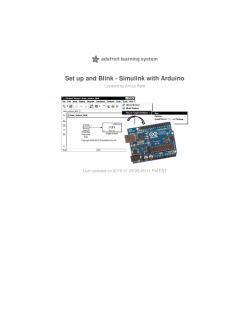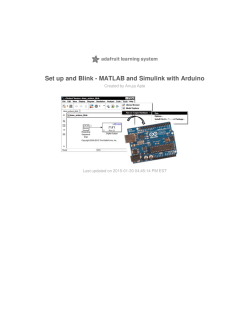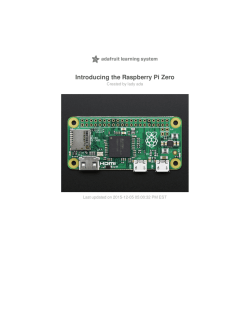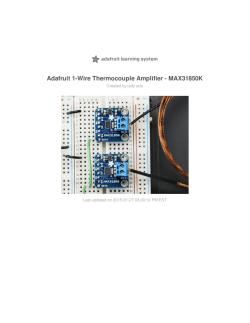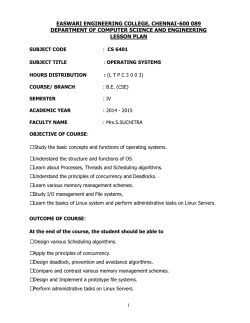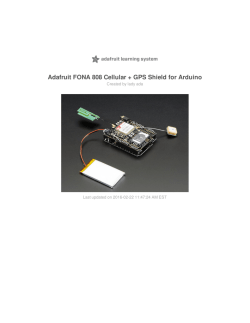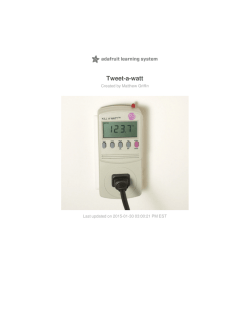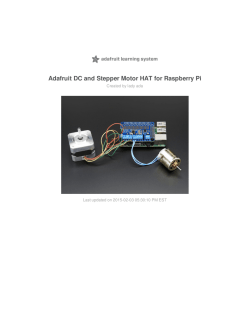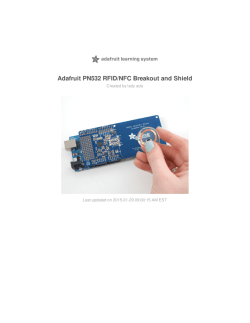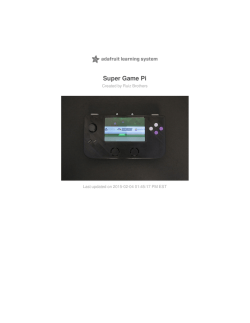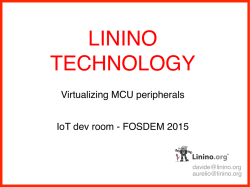
Download PDF - Adafruit Learning System
What is this "Linux", anyhow?
Created by Brennen Bearnes
Last updated on 2015-01-30 04:15:13 PM EST
Guide Contents
Guide Contents
2
Overview
3
Linux is an operating system
4
Linux is an operating system
4
Linux is a kernel, which put together with software from GNU and BSD and lots of other
places, makes up an operating system
4
So what is an operating system?
4
What is in an Operating System?
5
Kernels vs "Bare Metal"
5
So Why an Operating System?
6
Do you need Linux for your projects?
10
Do you need to use Linux for your projects?
10
When you DONT want to use Linux
10
When you WANT use Linux
11
What about choosing a distribution?
12
Wait! What's a distribution?
12
Picking a distro for the Pi or BeagleBone
14
Get you a Linux Computer
15
Buy a single-board computer
15
Option 1 - Raspberry Pi
15
Option 2 - BeagleBone Black
16
Use your existing desktop or laptop
18
Run Linux in the cloud
18
Ready? Set...
19
© Adafruit Industries
https://learn.adafruit.com/what-is-linux
Page 2 of 19
Overview
EDITOR'S NOTE: Hiya, Lady Ada here to introduce this tutorial! If you're starting down the
path to learning about electronics or computers, you may have noticed or heard about
"Linux" - as in "this dev board is linux-based" or "this wearable runs linux" or "I wrote a linux
script to control the barcode scanner"
And you might be wondering Well, what is this "Linux" anyho w? Do es it matter to
me? and then maybe you asked someone and you got a long rant about stuff called
kernels and bashed shells and now you're wondering if it's corn-related or is some sort of
crab.
Being that this question and confusion is inevitable, and we're getting so many people
asking about this mysterious Linux, we at Adafruit thought we'd write up a series of tutorials
to help you understand what linux is, when yo u want linux and ho w to use it when
yo u do .
This is the first in the series, take it away Brennen!
© Adafruit Industries
https://learn.adafruit.com/what-is-linux
Page 3 of 19
Linux is an operating system
Tux penguin, the mascot of Linux! (http://adafru.it/ej4)
Let's begin with the most basic explanation of what Linux is:
Linux is an operating system
Actually, let's amend that:
Linux is a kernel, which put together with software
from GNU and BSD and lots of other places, makes up
an operating system
OK, great! We're done here, pack up and lets go home!
Just kidding... While those statements are factual, they don't explain much.
So what is an operating system?
An Operating System (we will shorthand it by saying OS) is the software that lets a computer
run other software. It bridges the gap between the complicated guts of computers
(processors! memory! hard disks! mouse! keyboard! video card!) and programs that need
to run on many different kinds of hardware.
For example, it would be really frustrating if you could only run your favorite game on
computers with AMD-brand processors and exactly 2 gigabytes of Crucial-brand RAM and
only Western Digital SATA-type hard drives. Or if your word processor would only work on a
© Adafruit Industries
https://learn.adafruit.com/what-is-linux
Page 4 of 19
desktop computer and not on a laptop. Since each computer is made of different parts from
different manufacturers (which lets you have a lot of flexibility in price, size, speed, etc) we
need to have co mmo n gro und language fo r talking to all the physical
hardware bits that make up yo ur deskto p o r lapto p.
That common ground/language is called the Operating System
Operating systems you may have heard of!
Micro so ft Windo ws 7 - and its little/big brothers 3.1, 95, NT, 98, XP, Media Edition,
8, 10
Po cket PC / Micro so ft Windo ws Mo bile - the lightweight mobile/phone versions
of Windows
Mac OS X - and previous versions like Mac OS 9, System 7, etc.
iOS - Apple's mobile/phone/tablet operating system
Unix, BSD, NeXT, Linux, So laris, etc. - the huge number of Unix-like operating
systems
There're tons more you can read about on Wikipedia (http://adafru.it/eiV)
Each one of these was developed by a group or company to talk to hardware in the way that
group thought best. In general (but not always) - software written for one Operating System
will not run on another operating system. You cannot run a Windows program on iOS
(emulators are an exception)
What is in an Operating System?
Modern operating systems contain a lot of software, but they’re usually all built around
something called a kernel, which is the core piece of code in charge of managing all that
hardware, things like processors, memory, hard disk drives, and network interfaces like
Ethernet or WiFi.
A kernel starts programs and controls the way that they share hardware resources,
coordinates driver code for different kinds of hardware, and makes it possible for software
(like your spreadsheet) to work without itself knowing the detailed specifics of hardware
(like which brand of monitor you are displaying the spreadsheet on).
Kernels vs "Bare Metal"
If you’ve worked with tools like Arduino or Propeller or PIC or other microprocessors, you’ve
probably written programs that run right on the “bare metal” of a microcontroller. In general,
when your code says something like this:
// the loop routine runs over and over again forever:
void loop() {
digitalWrite(led, HIGH); // turn the LED on (HIGH is the voltage level)
delay(1000);
// wait for a second
© Adafruit Industries
https://learn.adafruit.com/what-is-linux
Page 5 of 19
delay(1000);
// wait for a second
digitalWrite(led, LOW); // turn the LED off by making the voltage LOW
delay(1000);
// wait for a second
}
…then the code in your loop is the only thing running, happily blinking that
LED (http://adafru.it/eir) 'til the end of time (or the end of your battery life, at any rate). You
could think of things as fitting together like this:
Other than the Arduino IDE and the compiler, there's nothing in the way of your commands
and the computer/microprocessor.
For lots of simple projects, this is a great approach: The hardware is low-cost and runs for
ages without much power. The code is simple and can get right down to business without
waiting for a lot of complicated stuff to boot up first.
So Why an Operating System?
So what happens when a device needs to do a lot of things at once — stuff like storing lots
of data, communicating across complex networks, and interacting with multiple users? What
if you want to be able to switch between different programs, or run the same program on
very different kinds of hardware? What if the users of your hardware want to be able to
reprogram it on the fly?
These are the problems that led the builders and users of early computers to write
operating systems. What they came up with looks a little more like this:
© Adafruit Industries
https://learn.adafruit.com/what-is-linux
Page 6 of 19
The kernel of a modern OS is a little bit like that loop() function, if you wrote it to enable all of
the stuff that you might want to do with a general purpose computer. However, instead of
just turning on/off an LED, it goes around to every single program and takes requests for
what the program wants.
That turns out to be a lot of stuff.
For example, this morning my kernel asked
"Hey MyPaint, whatcha need?"
and MyPaint replied
"Hey can yo u draw so me red pixels o ver here o n the mo nito r"
and the kernel commands the video driver to do that.
Then it went over to the IM client and said
"Hey IM client, whatcha need?"
and the IM client said
"Hey I also need yo u to draw to the mo nto r, this little no tice that a new
message came in AND also can yo u play a ding-to ne o n the speaker?"
and the kernel replied and said "no problem" and told the sound driver and video card to do
those things. The more programs running at once, the more the OS/Kernel has to chat to
each one, asking what it wants and doing those tasks.
Note that some times, the kernel/o perating system canno t handle o r do the
request! That's when you get program crashes, blue-screens-of-death, error boxes, etc.
MyPaint may say "Cool time to save this image file, please save it to disk!" and the OS will
reply "Sorry! No more disk space!"
© Adafruit Industries
https://learn.adafruit.com/what-is-linux
Page 7 of 19
Shmuel Csaba Otto Traian CC BY-SA 3.0 (http://adafru.it/eis), via Wikimedia
Commons (http://adafru.it/eit)
OK, so now you know what an Operating System is. Linux is one member of a huge family of
operating systems descended from something called Unix (http://adafru.it/eiu).
Linux-based OSes serve the same essential purpose as Microsoft’s Windows or Apple’s OS
X (also a Unix-derivative!), but it’s a very different animal in some important ways. For one
thing, its code is freely available to everyone. For another, there is no single, “official” form
of the Linux operating system. Instead, many groups offer versions for different needs and
purposes.
They may not be directly visible, but you probably use lots of computers running Linux, or at
least the Linux kernel. That’s because it runs on millions of the machines that make up our
networks and infrastructure: Systems ranging from tiny embedded devices to enormous
supercomputers used for scientific work, and nearly everything in-between.
For example, here're some common products/devices that run Linux:
Android phones and tablets
40-80% of the public servers on the internet (http://adafru.it/eiv) (including this one!)
Kindle and many other e-readers (http://adafru.it/eiw)
WiFi home gateways / routers (http://adafru.it/eix)
Video game systems (http://adafru.it/eiy)
DVRs (http://adafru.it/eiz)
© Adafruit Industries
https://learn.adafruit.com/what-is-linux
Page 8 of 19
There’s a pretty good chance you already have a Linux machine or two in your house — or
your pocket.
© Adafruit Industries
https://learn.adafruit.com/what-is-linux
Page 9 of 19
Do you need Linux for your projects?
Now that you know what Linux is, you might be thinking "Wow that's great, it would be really
nice to run 'programs' on my Arduino instead of messing around with interrupts for when I
want to drive Servos and NeoPixels at the same time (http://adafru.it/eiW)".
Do you need to use Linux for your projects?
Maybe not, for a lot of things! A full modern operating system is overkill for many problems,
and lots of simple, modular hardware tools are available these days. It’s easier than it ever
has been to build a gadget using Arduino+sensors+display and teach it what you need it to
do.
On the other hand, little computers that run Linux well can be had for less than $50, and Linux
is an incredibly powerful platform.
When you DONT want to use Linux
OK this isn't a hard and fast list of rules, but more stuff to keep in mind when you are
deciding whether to use a Linux-based computer or go with something embedded/"bare
metal"
Po wer requirements are way higher for 'computers' - a microcontroller can use
under a milliWatt, its tough to get a linux computer under 1 Watt. You may also have
cooling management to deal with if your linux board is running 'hot'
Speed-to -bo o t: if you don't have a bootloader, a microcontroller will start running its
'program' in milliseconds or less. Linux computers tend to require at least a minute,
although you can sometimes tweak this down or it can take much more
Disk Co rruptio n: barring cosmic rays (http://adafru.it/eiX), once a program is
burned into the FLASH of an Arduino chip, it's there for life. You can turn it on 50 years
from now and it'll be exactly the same. Linux computer disk drives can get corrupted
by power fluctuations and can 'fail to boot' if data is not written correctly (there are
ways to avoid this but its a bit of work and never completely foolproof)
Size: Computers need a lot of stuff like FLASH, RAM, bus managers, multiple power
supply regulators, they'll be bigger physically
Price: All those parts cost $ too! You can DIY an Arduino for a few $, but its hard to
get a linux computer for under $25. It's not much but if you need to make a lot of your
project, it adds up!
"Real Time" needs: If you are trying to perform a task with very specific timing
requirements, like "precisely 0.5 milliseconds after this button is pressed, activate the
flash bulb", a microcontroller will excel because it does not have to kernel running
around from task to task. It will listen for the button, then wait for the exact amount of
time. With linux, the kernel is doing all this stuff in the background, so many timingspecific stuff can be a challenge.
Co mplexity: With so many interplaying parts, a lot more can go wrong...
© Adafruit Industries
https://learn.adafruit.com/what-is-linux
Page 10 of 19
When you WANT use Linux
A robust, modern OS makes it easy to speak network protocols (TCP/IP! SSL!), process
large/complicated files like compressed photos/music/video, use low-cost off-the-shelf
hardware that talks over USB, and grants access to countless different programming
languages and other tools:
A traditional Unix shell and the GNU core utilities (http://adafru.it/ema)
Languages like: C/C++, Go, Python, Ruby, Perl, Scheme, PHP, and Java
Frameworks like: Node.js (including libraries written especially for embedded
development (http://adafru.it/eiA)) and Flask (http://adafru.it/emb)
Package managers and repositories like apt (http://adafru.it/eiB),
npm (http://adafru.it/eht), CPAN (http://adafru.it/eiC), pip,
Packagist (http://adafru.it/eiD), and RubyGems (http://adafru.it/eiE), offering fast
access to tens of thousands of open source applications and libraries
A full TCP/IP network stack and toolset
Easy and familiar file storage to disk drives and SD cards
Mature databases like PostgreSQL (http://adafru.it/eiF), MySQL, and
SQLite (http://adafru.it/eiG)
Web servers like nginx (http://adafru.it/eiH), Apache (http://adafru.it/eiI), and
lighthttpd (http://adafru.it/eiJ)
Linux is a gateway to half a century’s worth of accumulated knowledge, and a bridge from
your work to the wider world.
It’s also — and this is important — totally within your reach to learn. In the rest of this series,
we’ll provide a gentle introduction to basic computing with Linux, touch on the history of its
key ideas, and explore how those ideas can be applied in creative work.
© Adafruit Industries
https://learn.adafruit.com/what-is-linux
Page 11 of 19
What about choosing a distribution?
OK now you have decided you are going to use Linux, you aren't done! Now you have to pick
the flavor of Linux, also known as a Linux distributio n.
We'll be using the Raspberry Pi for most examples throughout this series, and it has its own
custom version of Debian GNU/Linux (http://adafru.it/eiY), called Raspbian
(a portmanteau (http://adafru.it/eiZ) of Raspberry+Debian (http://adafru.it/ej0)) which is a
reliable operating system with tons of pre-packaged software available. I recommend you
start with this distribution since it is popular, easy to get started with, and well maintained,
but I'll discuss other options in a moment.
Wait! What's a distribution?
First, it's helpful to know what a "distro", short for "distribution" is: The Linux kernel bundled
up and distributed with a whole bunch of other software to create a complete operating
system that you can actually use.
This is kinda like how if you have a Windows or Mac computer, it comes with a basic text
editor (SimpleText or WordPad), a game or two, a web browser (like Safari or Internet
Explorer), and more.
© Adafruit Industries
https://learn.adafruit.com/what-is-linux
Page 12 of 19
...and so on and so forth. It's a lot of work, assembling an operating system.
A distribution represents a set of choices about how an OS should fit together and what
things it should do well. It usually comes with a system for updating itself and installing new
software, and how this problem is solved is one of the defining qualities of a distribution.
There are a lot of different distributions (http://adafru.it/eiK) out there. Some of them have
been around for decades; others are only months old. It’s a constantly changing landscape,
and it can be easy to get overwhelmed by all the options.
Choosing a distribution is often just a question of deciding what your priorities are for a
project. Some place a special emphasis on including only free software, being a friendly
desktop system, or security. Others are meant to run on specific kinds of computers, like
small low-power devices or warehouses full of servers. There's over 100 different Linux
distributions (http://adafru.it/ej3) you can choose from (although not all of them may support
© Adafruit Industries
https://learn.adafruit.com/what-is-linux
Page 13 of 19
the Pi or BBB out of the box)
Picking a distro for the Pi or BeagleBone
For little computers like the Raspberry Pi and the Beaglebone Black, distributions are
available for tasks like running a media center (http://adafru.it/eiL), building an arcade
game (http://adafru.it/ej1), testing the security of a school or company
network (http://adafru.it/ej2), developing hardware projects, etc. etc.
In general, we suggest sticking with the default distribution that comes with or is suggested
for a computer. For Pi that's going to be Raspbian, for BBB that would be Debian, for a
desktop or laptop computer, Ubuntu or Debian are popular.
We'll explore some of those in depth in later articles in this series. For now, let's...
© Adafruit Industries
https://learn.adafruit.com/what-is-linux
Page 14 of 19
Get you a Linux Computer
If you're interested in giving Linux a try, there are a lot of options. I'll break down three of the
easiest.
Buy a single-board computer
One of the easiest things you can do at this stage of history is buy a low-cost, standalone
computer designed to run GNU/Linux.
Option 1 - Raspberry Pi
The Raspberry Pi is a simple, tiny device intended for educational environments and the
learning of basic computer science topics. If you have a keyboard, mouse, and TV or
monitor, you can plug directly into it.
We'll be using the Pi as a baseline system for articles in this introductory series because it's
easy to come by, designed for teaching, and has a great community.
© Adafruit Industries
https://learn.adafruit.com/what-is-linux
Page 15 of 19
The Adafruit Learning System offers an ongoing series of introductory Raspberry Pi
articles (http://adafru.it/dS4), including detailed instructions on preparing the Pi for first
boot (http://adafru.it/eiM) and first time configuration (http://adafru.it/eiN).
Best of all it's low cost enough, you can get started for $100 - less if you already have some
of this stuff around. We recommend at least:
Raspberry Pi Model B+ (http://adafru.it/dH0)
A case for for the Pi (http://adafru.it/ej5)
A good power supply (http://adafru.it/1995) for the Pi
4GB SD card pre-burned with the Raspbian OS (http://adafru.it/1121)
WiFi USB Stick (http://adafru.it/1012) to get the Pi online
USB Console Cable (http://adafru.it/954) so you can talk to the Pi from a desktop or
laptop
If you want to get a pack with all this and some other handy parts, pick up:
Raspberry Pi Model B+ Starter
Pack
http://adafru.it/2125
Option 2 - BeagleBone Black
© Adafruit Industries
https://learn.adafruit.com/what-is-linux
Page 16 of 19
The BeagleBo ne Black is, like the Raspberry Pi, a little computer on one board. It
features a substantially faster processor, onboard storage, and a broader array of hardware
interfaces than the Pi. It also lets you connect to a nice web-based interface over a USB
cable out of the box, which means you can get started without a spare keyboard & monitor
or messing around with network configuration.
On the other hand, it has fewer USB ports and no headphone jack, and offers less in the way
of graphics capability. The supply has also been somewhat constrained, making it a harder
gadget to come by, and fewer units in the wild means there's not as much written about
using it, so there are not as many tutorials and projects. In that sense, the BBB is more
"cutting edge".
The BBB is a beautiful little device, and you probably won't go wrong getting one. It might be
most appropriate for cases where it's not going to be the only standalone computer in a
room, or where you plan to do a lot of hardware hacking.
We've also got you covered on tutorials for the BeagleBone (http://adafru.it/eiO), and the
System Reference Manual (http://adafru.it/eiP) is a quality old-school manual, if you're into
that kind of thing.
© Adafruit Industries
https://learn.adafruit.com/what-is-linux
Page 17 of 19
Beaglebone Black Starter Pack
http://adafru.it/703
If you're still not sure what to buy and want to get into the nitty-gritty, we've also got a
detailed comparison of popular embedded Linux boards (http://adafru.it/eiQ).
Use your existing desktop or laptop
If you're reading this, there's a fair chance you already have a machine capable of running
Linux well.
The traditional approach is to boot Linux directly on your machine. If you want to go this
route, the easiest option is probably to install Ubuntu (http://adafru.it/eiR), a widely-used
close relative of Debian which supports a lot of recent hardware.
Another option here is to run a distribution on a virtual machine on top of your existing
operating system. VirtualBox (http://adafru.it/eiS) is a widely-used, open source way to host
other operating systems on x86 computers, including Mac and Windows systems. To make
this easy, you can use Vagrant (http://adafru.it/epl) to quickly spin up a new virtual machine check out the first page of their Getting Started guide (http://adafru.it/epm) and you should
be Linuxing in no time.
Run Linux in the cloud
© Adafruit Industries
https://learn.adafruit.com/what-is-linux
Page 18 of 19
You don't have to use your own hardware to get a virtual machine — lots of services exist to
host them for you.
Big companies you've heard of, like Amazon and Google, offer lots of cloud services. A lot
of the internet runs on these, especially Amazon's offerings.
There's a lot of good material on using the cloud, but it can all be a bit overwhelming. Right
now, I'll suggest a provider I've been using lately called DigitalOcean (http://adafru.it/eiU),
who offer an easy signup process, a simple web interface, and lease basic machines for
about $5 a month.
DigitalOcean is pretty easy to use, but as with VirtualBox we'll soon post detailed guidance
on setting it up.
Ready? Set...
We hope this tutorial helped you understand what we mean by operating system, kernel,
Linux, and distribution! It's a lot to learn so keep in mind you may have to refer back to this
tutorial in the future when we chat about kernel modules and package management.
Next up, we'll be exploring the details of setting up a new Linux system, understanding the
command line, and getting real work done with the Linux toolset - so boot up your Linux
system and sew that Tux patch onto your jacket! (http://adafru.it/ej6)
© Adafruit Industries
Last Updated: 2015-01-30 04:15:15 PM EST
Page 19 of 19
© Copyright 2025
